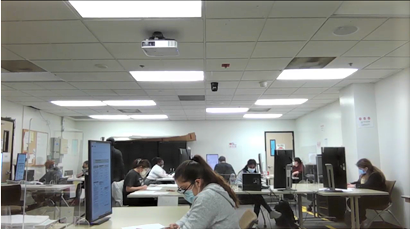 The L.A. County Registrar’s Tally Operation Center in Downey during the Official Election Canvass following the November 3 election. Tally audits and other voting operations could be observed via several cameras over a live feed. (Courtesy lavote.net)
The L.A. County Registrar’s Tally Operation Center in Downey during the Official Election Canvass following the November 3 election. Tally audits and other voting operations could be observed via several cameras over a live feed. (Courtesy lavote.net)
We have witnessed an extraordinary election! As advocates for women’s rights, we acknowledge and celebrate the great feat voters across the United States have achieved, sending the first woman, the first Black person, and the first person of South Asian descent to Washington, D.C., to become vice president!
But that is not all. Voters are on the way to shattering records for the sheer number of ballots cast. The United States Election Project is forecasting that once all votes are counted, 66.6 percent of all eligible voters (159,231,526 of 239,247,182) will have cast ballots in the November Presidential Election. That percentage of voters has not been reached since 1900! In California alone, according to Emily DeRuy and Harriet Blair Rowan from the Bay Area News Group, we are expected to top 17.5 million voters in the November election. That is 3 million more ballots cast than in the 2016 presidential election.
So it is no surprise that, as I write, the state of California is still counting votes! Not to worry—this is normal. After election night, thousands of ballots need to be counted. Legally mandated processes are used to guarantee that every vote is counted and included in the official final election returns, which are not officially due until December.
California state law recognizes the difficulty of completing the ballot count and allows election officials up to thirty days to complete and certify election results. The ballot count includes a thorough audit of the election results to ensure accuracy. Ballots are sampled randomly and manually tallied to verify that the machine counts are correct. This process is known as the 1% Manual Tally Audit. We have complete transparency in conducting the ballot count. This is especially important in this election, which was fraught with widespread allegations of voter fraud in many states. These allegations were not based on evidence but, rather, on rumor mills fueled by social media. Nonetheless—in an election where state secretaries of state and election officials of all parties have attested to the accuracy of results that were witnessed in real time by bipartisan observers—vote recounts are the order of the day. And the recounts have proved the election officials to be correct.
In Los Angeles County, the ballot-counting process is open to public observation. The count is conducted at the Registrar’s Downey Tally Operation Center (located at 9150 East Imperial Highway in Downey). The last two days for public observation are November 27 and 30 from 1:00 to 4:00 p.m. These hours are subject to change; you can review them by checking the Canvass Update Schedule, posted on the L.A. County Registrar’s website. Other pages that provide county, state, and national election results include the Registrar’s results page, CalMatters’ results page, and Ballotpedia’s Presidential Election Results 2020.
Once the Registrar certifies and posts the final voter counts in L.A. County, we will review voter turnout in our thirteen foothill communities and compare it to prior election turnouts. Cross your fingers!
Of course, we still await the convening of the Electoral College on December 14. Read Thad Zajdowicz’s article on the importance of the Electoral College, and for a more detailed explanation of the Electoral College, consult Ballotpedia and the 2020 time line and explanation issued by the Congressional Research Service. Explore the mystery and think about reform!
—Martha Y. Zavala, President and Voter Services Committee Chair